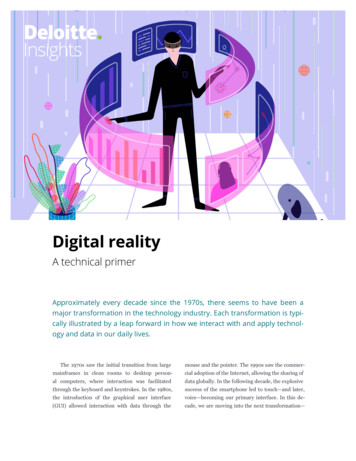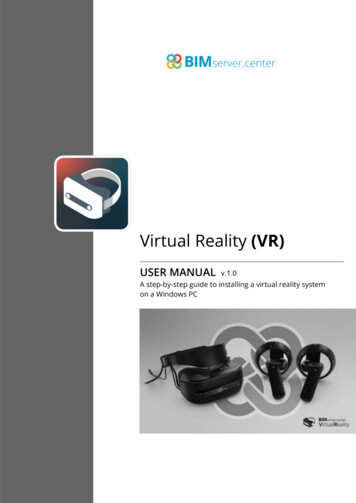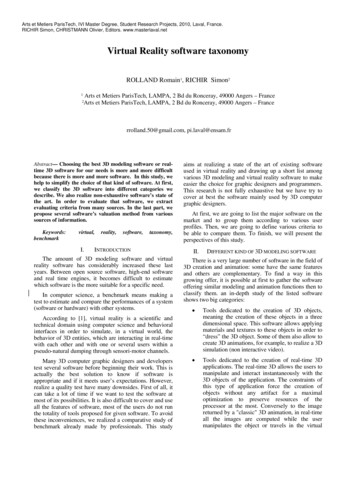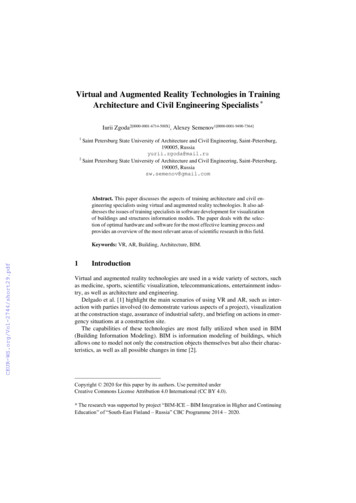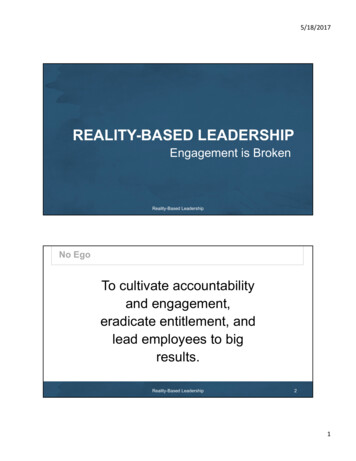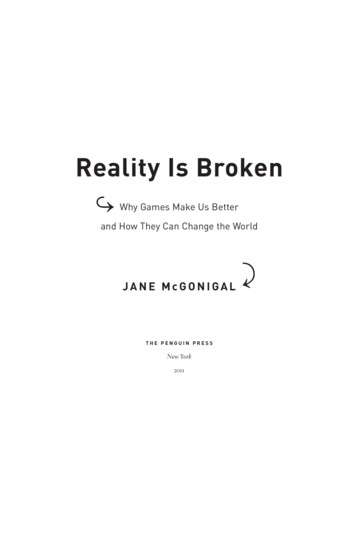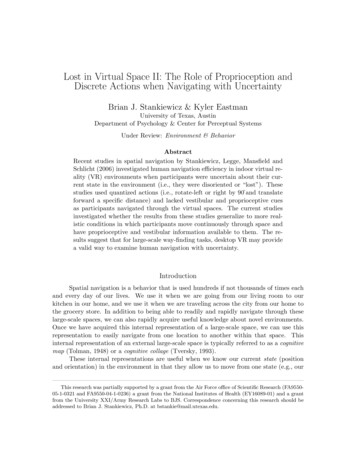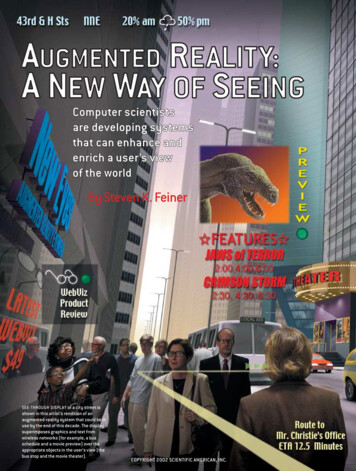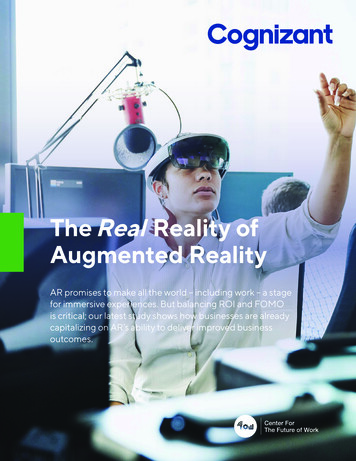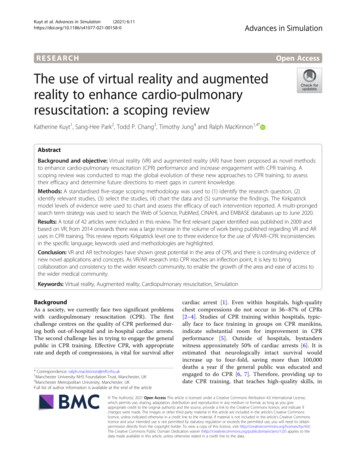
Transcription
Kuyt et al. Advances in Simulation(2021) ARCHOpen AccessThe use of virtual reality and augmentedreality to enhance cardio-pulmonaryresuscitation: a scoping reviewKatherine Kuyt1, Sang-Hee Park2, Todd P. Chang3, Timothy Jung4 and Ralph MacKinnon1,4*AbstractBackground and objective: Virtual reality (VR) and augmented reality (AR) have been proposed as novel methodsto enhance cardio-pulmonary resuscitation (CPR) performance and increase engagement with CPR training. Ascoping review was conducted to map the global evolution of these new approaches to CPR training, to assesstheir efficacy and determine future directions to meet gaps in current knowledge.Methods: A standardised five-stage scoping methodology was used to (1) identify the research question, (2)identify relevant studies, (3) select the studies, (4) chart the data and (5) summarise the findings. The Kirkpatrickmodel levels of evidence were used to chart and assess the efficacy of each intervention reported. A multi-prongedsearch term strategy was used to search the Web of Science, PubMed, CINAHL and EMBASE databases up to June 2020.Results: A total of 42 articles were included in this review. The first relevant paper identified was published in 2009 andbased on VR, from 2014 onwards there was a large increase in the volume of work being published regarding VR and ARuses in CPR training. This review reports Kirkpatrick level one to three evidence for the use of VR/AR–CPR. Inconsistenciesin the specific language, keywords used and methodologies are highlighted.Conclusion: VR and AR technologies have shown great potential in the area of CPR, and there is continuing evidence ofnew novel applications and concepts. As VR/AR research into CPR reaches an inflection point, it is key to bringcollaboration and consistency to the wider research community, to enable the growth of the area and ease of access tothe wider medical community.Keywords: Virtual reality, Augmented reality, Cardiopulmonary resuscitation, SimulationBackgroundAs a society, we currently face two significant problemswith cardiopulmonary resuscitation (CPR). The firstchallenge centres on the quality of CPR performed during both out-of-hospital and in-hospital cardiac arrests.The second challenge lies in trying to engage the generalpublic in CPR training. Effective CPR, with appropriaterate and depth of compressions, is vital for survival after* Correspondence: ralph.mackinnon@mft.nhs.uk1Manchester University NHS Foundation Trust, Manchester, UK4Manchester Metropolitan University, Manchester, UKFull list of author information is available at the end of the articlecardiac arrest [1]. Even within hospitals, high-qualitychest compressions do not occur in 36–87% of CPRs[2–4]. Studies of CPR training within hospitals, typically face to face training in groups on CPR manikins,indicate substantial room for improvement in CPRperformance [5]. Outside of hospitals, bystanderswitness approximately 50% of cardiac arrests [6]. It isestimated that neurologically intact survival wouldincrease up to four-fold, saving more than 100,000deaths a year if the general public was educated andengaged to do CPR [6, 7]. Therefore, providing up todate CPR training, that teaches high-quality skills, in The Author(s). 2021 Open Access This article is licensed under a Creative Commons Attribution 4.0 International License,which permits use, sharing, adaptation, distribution and reproduction in any medium or format, as long as you giveappropriate credit to the original author(s) and the source, provide a link to the Creative Commons licence, and indicate ifchanges were made. The images or other third party material in this article are included in the article's Creative Commonslicence, unless indicated otherwise in a credit line to the material. If material is not included in the article's Creative Commonslicence and your intended use is not permitted by statutory regulation or exceeds the permitted use, you will need to obtainpermission directly from the copyright holder. To view a copy of this licence, visit http://creativecommons.org/licenses/by/4.0/.The Creative Commons Public Domain Dedication waiver ) applies to thedata made available in this article, unless otherwise stated in a credit line to the data.
Kuyt et al. Advances in Simulation(2021) 6:11an engaging manner for both healthcare professionals andmembers of the public, is of great importance. Further tothis, the recent novel coronavirus (COVID-19) pandemichas led to an increased urgency to reduce grouptrainings, especially where trainees are in continuedclose contact, such as many of the current CPR trainingmethods.Virtual reality (VR) has been proposed as potentially apowerful tool to enhance interaction and performancewith manikin simulators [8]. Augmented reality (AR)solutions to improve CPR engagement, using commercially available devices such as Google Glasses (Google,Mountain View, California, USA) and Microsoft HoloLens(Microsoft, Redmond, Washington, USA), are alsoappearing [9, 10].For the purposes of this review, a training device hadto provide an immersive experience to be classed asusing virtual reality techniques. This is in agreementwith Cant et al [11] who suggest a definition of VRwithin healthcare as a technology that uses fidelity,immersion and patient depiction. Augmented realityshould also use technology to provide a multi-sensoryexperience environment for the user; however, this isnot always exclusively immersive. The field of VR andAR based CPR solutions is developing promisingly at thetime of this writing, with new proposals and early validation studies. The spread of COVID-19 has led to an increase in interest in how innovative technologies, suchas VR and AR, may be utilised to limit the unnecessaryphysical interaction of people. To date, there has beenno review that has focused on the evolution of the VRand AR based CPR solutions. This scoping review aimsto review published material on VR and AR in CPRtraining to evaluate the evidence of its efficacy in enhancing learning, knowledge, skills, and attitudes. Also, toprovide suggestions regarding how the field can continueto develop and provide increasing utility in teachingCPR skills.MethodsA scoping review provides an initial insight into thecontent and breadth of developing heterogeneous datafrom diverse sources, prior to embarking on a systematicreview on deeper established datasets [12, 13]. Thisscoping review utilised the Preferred Reporting Items forSystematic reviews and Meta-Analyses extensions forScoping Reviews [14]. The methods of this review werebased on the five-stage methodology of Levac,Colquhoun and O’Brien [15].1.2.3.4.Identify the research questionIdentify relevant studiesSelect the relevant studiesChart the dataPage 2 of 85. Summarise and report the resultsIdentify the research questionAs technologies including VR and AR continue toevolve, become less expensive and within the reach ofresearchers, the next step to potential applications inhealthcare staff training comes in to sight. Globally, CPRtraining inside and outside of healthcare remains challenging and the evidence base for the application of VRand AR to CPR is beginning to grow. This growth hasled to the proposal of the question ‘Can VR and/or ARimprove CPR training?’ This in turn was developed further to focus upon the educational outcomes of basic lifesupport training, using the Kirkpatrick model. The resultant research question of ‘Can VR and/or AR enhancelearning, knowledge, skills or attitudes and if applied,was there an outcome concerning basic life supportskills?’ This question was deemed broad enough to capture the current evidence base yet focused enough to indicate areas and direction for development of theliterature further.Eligibility criteriaIn order to be included, the identified article had to beon the topic of life support training or performance anduse of VR and/or AR as a teaching or feedback tool. Nolimitations on date or language were filtered for thissearch; English-language translations were procured forthose written primarily in a different language.Articles were excluded if they were opinion pieces rather than unbiased reviews/studies, or did not use VR orAR methods for CPR. To be classed as virtual reality, themethodology had to include an immersive element.Identify relevant studiesA multi-pronged search term strategy was used tosearch the Web of Science, PubMed, CINAHL andEMBASE databases in June 2020. Articles were requiredto have terms from both topics of CPR and VR/AR.Terms for CPR included heart massage, artificial respiration, cardiopulmonary resuscitation, CPR, basic lifesupport, heart stoppage, cardiac massage, heart massage,circulatory arrest. VR/AR terms included computersimulation, user-computer interface, virtual reality, augmented reality, computer simulation, computer assistedtherapy (Table 1). Google scholar was also searched, aswere hand searches on full text articles. Duplicates wereremoved by an author (KK).Study selectionOne author and an expert librarian conducted thesearch. Three authors screened and full text reviewedthe resultant findings (KK, S-HP and RM); study
Kuyt et al. Advances in Simulation(2021) 6:11Page 3 of 8Table 1 Full search strategy used for database searches on Webof Science, PubMed, CINAHL and EMBASE(“heart massage” or “artificial respiration” or “cardiopulmonaryresuscitation” or CPR or “basic life support” or “heart stoppage” or“cardiac massage” or “heart massage” or “circulatory arrest”)And(“computer simulation” or “user-computer interface” or “virtual reality” or“augmented reality” or “computer simulation” or “computer assistedtherapy”)selection was confirmed by discussion and consensus byall the authors.Charting the dataMicrosoft Excel 2013 (Redmond, WA, USA) was used togather and display relevant information regarding eachof the selected studies. The data-charting matrix was developed collaboratively by two authors (RM and TC) todetermine which metrics and data to collect. This included subject of study (virtual reality or augmentedreality), year of publication, geography of study, sourceof publication and impact factor (June 2020).The findings of the studies were assessed and reportedbased on the Kirkpatrick model, which is used to assessthe efficacy of a specified training or intervention. TheKirkpatrick model can be used to evaluate how likely atraining programme is to meet the needs of both the organisation and the trainees. It consists of four levels ofevidence, assessing the reaction to training, skills learnt,behaviours and outcomes [16] (Table 2).Synthesis and reporting of resultsStudies were grouped according to the main methodused/reported, that of VR or AR. Also, studies werestratified according to the Kirkpatrick model, and whichlevel of evidence they supplied. The information collatedin this literature search was reviewed to provide an overview of the existing knowledge and findings on this topicand identify gaps in the literature.ResultsThe search resulted in 696 articles, of which 534 wereexcluded by title, and 71 were excluded on review of theabstract. An additional 49 studies were identified as duplicates and removed. Forty-two articles were includedin this review (Fig. 1). Of these articles 29 wereFig. 1 Flow diagram of the review of search results for theliterature reviewregarding VR, and 13 were studies based on AR. A fulllist of included articles can be found in Additional file 1.Publications by yearThe first original article published on these topics was in2009 and reported on the acceptance of, and interest in,a newly developed prototype of a virtual reality enhanced manikin (VREM) [17]. The following year, further data on this VREM was presented during aconference [18]. In addition, in 2010, a review discussingthe potential uses of VR in nursing education and CPRwas published [19]. From 2016, there has been an exponential growth of publications regarding VR and AR inCPR. Although the data was collected only part waythrough 2020, the expectation is for this trend to continue. Earlier publications reviewed the use of VR; thefirst of the included publications based on the use of ARtechnology was not published until 2016 [20] (Fig. 2).Geography of publicationsPublications were identified from twelve different countries (see Table 3). The first original article on these topicswas published by an Italian team in 2009 [17] and thisteam has since continued to publish on the topic [18, 21–23]. Research groups in the USA have also significantlycontributed to the literature on the use of VR and AR inCPR. This review identified 16 publications (6 articles, andTable 2 The Kirkpatrick levels of evidence to assess intervention efficacyLevel 1Participants react favourably to the learning or intervention.Level 2Participants acquired knowledge, skills and attitudes based on the intervention or study.Level 3Participants applied what they learnt into practice.Level 4Once applied, there was an outcome to that application of skills learnt from the intervention.
Kuyt et al. Advances in Simulation(2021) 6:11Page 4 of 8Fig. 2 Graphical representation of publications per year. Data collected June 202010 conference abstracts) from primarily USA based teamsranging in publication from 2010 to 2020. In contrast, although British teams have published multiple papers onthe subject [24–27], the first of these papers was not published until 2019.Source of publicationTwenty-four publications were articles, and 18 werepublished abstracts from conferences. A number of thearticles were published in high impact journals such asCirculation. Resuscitation, another journal with a highimpact factor, has published many publications on thetopics of VR and AR in CPR; both conference abstractsand full articles (Additional file 2).Table 3 Nationality of the research teams and year of firstpublication from that country. When authors were frommultiple nations, the nationality of first author was usedCountryYear of first Netherlands2020Singapore2018Spain2017Sri hor keywordsAuthors used a large variety of keywords throughout thepapers. The most prominent words were ‘reality’, ‘resuscitation’, ‘virtual’. There was a discrepancy in the use of‘VR’ versus ‘virtual reality’. Additionally, some excludedpapers had used the term ‘virtual reality’, where thestudy protocol did not align with standard definitions ofVR as of this publication.Assessment of outcomes—Kirkpatrick modelLevel 1: feasibility and reactionRegardless of the effectiveness of VR and AR in CPRtraining and provision, they are of limited utility unlessthey are accepted by the workforce and trainers. Thisaligns with level one of evidence in the Kirkpatrickmodel. In the first novel paper included in this review,Semeraro et al (2009) evaluated the acceptance of theVREM (VR enhanced manikin) prototype, 85% of participants stated the VR experience was interesting and believed it could be very useful for healthcare training [17].However, the sample for this study consisted of volunteers to review the manikin who were already attendinga medical congress, and therefore have a large potentialto be biased.Wong et al (2018) surveyed 30 CPR instructors regarding their views on the use of VR in CPR training, reporting that VR was viewed by the instructors as havingpotential as a blended learning tool, for both novice andexperienced healthcare professionals [28]. Additionally,there has been positive feedback from participants whoused VR for CPR training, with reports of an increase inskill confidence [25, 29], and users finding VR userfriendly [10, 17, 30]. Recently, Balian et al. have expanded the concept of AR CPR training further. Participants undergoing the AR training (n 51) had real-time
Kuyt et al. Advances in Simulation(2021) 6:11feedback, via a holographic overlay of blood flow to vitalorgans, which was dependent on the quality of chestcompressions being performed. Ninety-eight percent ofthe participants felt the visualizations were helpful fortraining, and 94% were willing to use the application infuture CPR training [31].Level 2: knowledge, skill and attitudesThe second level of evidence in the Kirkpatrick model isevidence of participants learning new knowledge orskills. Multiple studies found that the use of VR and ARduring CPR training led to an increased in the practicalskills of CPR [25, 29, 32]. The skill increase post VR/ARbased trainings were shown to be at least comparablewith traditional classroom methods; however, it is notestablished that VR and AR leads to greater skill improvement [30, 33, 34]. Siebert et al (2017) studied theeffects of wearing AR glasses during a simulated paediatric arrest. They compared the adherence to AmericanHeart Association guidelines when wearing AR glassesor when referring to pocket reference cards. Althoughmany measured outcomes did not change, participantswearing the glasses demonstrated improved adherencewith administrating the correct defibrillation doses [35].Level 3: application of knowledgeMultiple studies [36, 37] went beyond looking at purelythe skills of CPR and used VR and AR technology to immerse participants into a simulated scenario in whichthey would be required to use their CPR skills. Thesescenarios attempt to address level three of the Kirkpatrick model, the application of knowledge. Studiesshowed increased engagement with the scenarios duringVR and AR-based training [36, 37]. Furthermore, Perezet al (2017) concluded that physician feedback via googleglasses during a simulated cardiac arrest improved therate of successful CPR [38].Level 4: outcomesThe highest level of evidence for a teaching/interventionusing the Kirkpatrick model is an improvement in patient/cardiac arrest victim outcomes. The authors werenot able to identify any published work on the influenceof VR and AR training on patient outcomes.DiscussionThe aim of the study was to evaluate the development ofresearch into the use of VR and AR to enhance CPRtraining and provision. The findings of this review indicate that this field of VR and AR CPR is both diverseand immature. There is also evidence that the field isgrowing and evolving with increasing publications andsubsequent citations stimulating the growth. Geographically, there is a spread of activity across developedPage 5 of 8countries, as expected of a new field that is highlydependent on advances in technology. The high numberof novel innovations and experimental studies presentedindicate that the field is ripe for future research and development. The higher proportion of VR studies may bereflective of the state of current technology. It is expected that the number of research articles regardingthe use of AR in CPR may increase in coming years.Several of the papers identified in this search were abstracts or details of innovative designs where the testingand results had not yet been published. This illustratesthe growth and potential of this area of study, and reflects the development and incorporation of high fidelitymanikins into emergency medicine [39]. Innovative designs varied from custom-designed VR wearable devices[40], to encouraging engineering students to engage withCPR training by designing a smartphone app [41]. Themajority of papers identified focused on CPR skills inhealthcare professionals, which aligns with the introduction of novel technology as it allows comparison to theinbuilt control of previous performance. However, several studies did recruit laypeople [29, 36]. Additionally,novel work by Lopez-Belmonte et al. demonstrated thatAR methods could be used to teach the basics of CPRcompressions to children as young as 5 years old [32].The reviewed publications show a wide range of methodologies to assess the use of VR and AR. Overall, thestudies illustrated that virtual technologies have beenwell received by instructors and those undergoing training (healthcare professionals and laypeople). There isevidence to show that VR and AR technologies are particularly well received by the ‘technology natives’ of theyounger generation [29, 32]. By engaging school childrenin learning CPR skills, we are enabling them to enterinto adulthood with the skills to improve the rates of bystander intervention. As AR develops, the potential usesof being able to augment the users physical surroundingwith the virtual world are numerous. The work of Balianet al. is an example of this; by adding the component ofthe user seeing the blood circulation around the manikin, there is the added aspect of not only auditory feedback but also visual [31]. AR expands on the technologyof VR and is a more recent development, therefore thereare less papers regarding the use of AR and CPR.Javaheri et al. developed an AR CPR trainer model,where participants can learn and practice CPR skills outof a classroom setting, using AR via a virtual teacher thatinstructs and provided feedback [42]. Similar work hasalso been presented by Moe et al. [43].The high rigor of the science generated to date isreflected by the number of publications in high impactpeer reviewed journals. This may also indicate that thenovelty of VR is of interest as of this writing, to editorsand readerships. Reviewing the authorship of the
Kuyt et al. Advances in Simulation(2021) 6:11included publications, it can be seen that there are emerging research groups; where the same team have severalpublications in the field of VR/AR CPR based in bothItaly and the USA.A lack of systematic reporting in terms of author keywords and lack of agreed-upon terminology was identified, which has led to a lack of cohesion in how work iscategorised within repositories. Of note, it was apparentthat there is a lack of consensus of what constitutes VR.Does virtual reality have to be a fully immersive experience, or can you class any situational-based learningusing technology as VR? Kardong-edgren et al [44] discussed the issue of the differing definitions of VR andconcluded that the key aspect was immersion into anenvironment through sensory richness. The same discrepancies are likely to occur as research into AR, whichat this stage should be used only to describe the liveoverlay of virtual situations on top the subject’s physicalsurroundings. However, as AR builds on rather than replaces the user’s surroundings, this could be through ascreen such as a tablet or smart phone, or through animmersive headset.These factors are likely to be limiting the visibility ofVR and AR research, both internally within the simulation medicine community, and externally to the widerreader and clinician. Standardization of keywords andterminology has been used in simulation-based education [29] and would likely be on benefit in VR and AR,providing an opportunity to coalesce researchers and advance the field further.Currently, the field of AR/VR CPR research is likely tobe at an inflection point in terms of publications as researchers within this topic span both experts in thedigital innovation and resuscitation science and the technology continues to rapidly advance. However, to enablesuccessful growth, it is vital to collaborate as a community of practice that mutually engages, shares resourcesand has joint accountability to shape this field of research and yield potential solutions to improve CPRquality and bystander CPR engagement. The International Network for Simulation-based Pediatric Research, Innovation & Education (INSPIRE network) is anexample of where this has been achieved [45]. It wasestablished to provide a framework of research needsand standardisation within paediatric simulation-basedscience and medicine [36] and encourages collaborationbetween persons and institutions [45]. Another forwardstep would be an agreement of a lexicon of terms anddefinitions to clarify the field and aid appropriate signposting for research findings and resources.The COVID-19 pandemic has led to a ‘new-normal’that poses significant challenges on how to learn andmaintain CPR skills. Gatherings of large groups arestrongly discouraged and, in many organisations, notPage 6 of 8allowed at all, the majority learning has been convertedto a socially distant or virtual format, and people are encouraged to keep a distance of 2-metres or more unlesswearing suitable persona protective equipment. Furthercollaborative exploration of the value of VR and AR CPRmay provide important insights on potential solutions tothese challenges, and the changing landscape of CPRtraining.LimitationsThe analytical methodology chosen was not a systematicreview, therefore the quality of the papers was notreviewed in-depth, and all were treated with equalweighting. Furthermore, our search terms selected mayhave missed other unique articles that could have otherwise met inclusion criteria, as the keywords for newtechnologies may still be evolving.ConclusionFrom 2009 to 2019, the number of peer-reviewed articlesand conference proceedings about VR and AR on CPRhas grown slowly but now exponentially, with geographical diversity and high impact. Published work has demonstrated that VR and AR technologies met level oneand two in the Kirkpatrick model to assess a teachingmethod. Early evidence suggests that trainees apply theknowledge they learn during VR and AR training sessions, but further evidence is needed, along with data regarding the outcome of the application of skills. Now isthe time to look to the future, building on the workreviewed in this paper, and grasping the opportunity fornew innovations to improve how healthcare professionals and the general public provide CPR.Supplementary InformationThe online version contains supplementary material available at nal file 1. The studies included in the scoping review.Additional file 2. The impact factor of the journals publishing VR ARCPR studies, in this review.AcknowledgementsThe authors would like to acknowledge the expertise and support of OliviaSchaff from Manchester University Foundation Trust Library Services.Authors’ contributionsKK, TCP, TJ and RM designed and developed the study. KK, S-HP and RMscreened and reviewed the articles. RM and TJ co-wrote the first draft. All authors contributed to the critical review and approval of the final paper.FundingThis project was unfunded.Availability of data and materialsWe did not collect any data or materials in this research.
Kuyt et al. Advances in Simulation(2021) 6:11Ethics approval and consent to participateNot applicable.Consent for publicationWe are not reporting any data obtained from any individual; therefore,consent is not required.Competing interestsThe authors declare that they have no competing interests.Author details1Manchester University NHS Foundation Trust, Manchester, UK. 2KoreaInstitute of Civil Engineering and Building Technology, Seoul, South Korea.3Children’s Hospital Los Angeles, Los Angeles, USA. 4ManchesterMetropolitan University, Manchester, UK.Received: 23 October 2020 Accepted: 7 February 2021References1. Wallace SK, Abella BS, Becker LB. Quantifying the effect of cardiopulmonaryresuscitation quality on cardiac arrest outcome: a systematic review andmeta-analysis. Circ Cardiovasc Qual Outcomes. 2013;6(2):148–56.2. Sutton RM, Niles D, Nysaether J, Abella BS, Arbogast KB, Nishisaki A, et al.Quantitative analysis of CPR quality during in-hospital resuscitation of olderchildren and adolescents. Pediatrics. 2009;124(2):494–9.3. Sutton RM, Wolfe H, Nishisaki A, Leffelman J, Niles D, Meaney PA, et al.Pushing harder, pushing faster, minimizing interruptions but falling shortof 2010 cardiopulmonary resuscitation targets during in-hospital pediatricand adolescent resuscitation. Resuscitation. 2013;84(12):1680–4.4. Cheng A, Brown LL, Duff JP, Davidson J, Overly F, Tofil NM, et al. Improvingcardiopulmonary resuscitation with a CPR feedback device and refreshersimulations (CPR CARES Study): a randomized clinical trial. JAMA Pediatr.2015;169(2):137–44.5. Taniguchi D, Baernstein A, Nichol G. Cardiac arrest: a public healthperspective. Emerg Med Clin North Am. 2012;30(1):1–12.6. London Ambulance Service NHS Trust Cardiac Arrest Annual Report2018/19. Clinical Audit and Research Unit, London Ambulance ServiceNHS Trust; 2019.7. Bohn A, Van Aken H, Lukas RP, Weber T, Breckwoldt J. Schoolchildren aslifesavers in Europe—training in cardiopulmonary resuscitation for children.Best Pract Res Clin Anaesthesiol. 2013;27(3):387–96.8. Haans A, Ijsselsteijn W. Mediated social touch: a review of current researchand future directions. Virtual Reality. 2006;9(2):149–59.9. Chaballout B, Molloy M, Vaughn J, Brisson Iii R, Shaw R. Feasibility ofaugmented reality in clinical simulations: using google glass with manikins.JMIR Med Educ. 2016;2(1):e2.10. Ingrassia PL, Carfagna F, Mormando G, Giudici E, Strada F, Lamberti F, et al.Augmented reality learning environment for basic life support anddefibrillation training: usability study. J Med Internet Res. 2020;22(5):e14910.11. Cant R, Cooper S, Sussex R, Bogossian F. What's in a Name? Clarifying theNomenclature of Virtual Simulation. Clinical Simulation in Nursing. 2019;27:26–30.12. Whittemore R, Knafl K. The integrative review: updated methodology. J AdvNurs. 2005;52(5):546–53.13. Williams B, Reddy P, Marshall S, Beovich B, McKarney L. Simulation andmental health outcomes: a scoping review. Adv Simul. 2017;2(1):2.14. Tricco AC, Lillie E, Zarin W, O'Brien KK, Colquhoun H, Levac D, et al. PRISMAextension for scoping reviews (PRISMA-ScR): checklist and explanation. AnnIntern Med. 2018;169(7):467–73.15. Levac D, Colquhoun H, O'Brien KK. Scoping studies: advancing themethodology. Implement Sci. 2010;5:69.16. Bates R. A critical analysis of evaluation practice: the Kirkpatrick model and
Charting the data Microsoft Excel 2013 (Redmond, WA, USA) was used to gather and display relevant information regarding each of the selected studies. The data-charting matrix was de-veloped collaboratively by two authors (RM and TC) to determine which metrics and data to collect. This in-cluded subject of study (virtual reality or augmented


